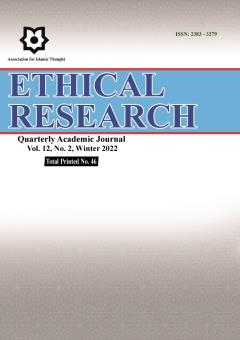Explaining the Different Ethical Approaches to the Antecedents and Consequences of Women's Conspicuous Buying
Subject Areas : Ethics and Islamic EducationAli Afshari 1 , Hamid Reza Saeidnia 2 , Hussein Vazifehdoost 3
1 -
2 -
3 -
Keywords: Conspicuous consumption, Luxury goods, Materialism, Religious community, Islamic ethics, National production. ,
Abstract :
This study aims to identify the factors affecting conspicuous consumption from the perspective of women with different lifestyles, including academics and seminarians, and also to investigate what actions conspicuous consumption leads to in individuals. This research is fundamental in terms of purpose and methodologically examines and analyzes the views of women on the conspicuous consumption of luxury goods using the grounded theory. The method of data collection is field and using semi-structured interview tools in two groups of the statistical population including 15 female students of Islamic Azad University, Tehran Science and Research Branch, and 15 female students of Al-Zahra seminary in Qom. The results of the study show the difference between the beliefs and views of the first and second groups regarding the concept of conspicuous consumption and show that female students of Islamic Azad University are more inclined to the conspicuous consumption of luxury goods and female students of Al-Zahra seminary are less inclined to the conspicuous consumption and seek to control it through paying attention to Islamic ethics and religious life. This difference in the views of students is based on causal factors including structural, behavioral, psychological, and social factors. This research has for the first time dealt with the concept of conspicuous consumption from two perspectives with different intellectual approaches and compares them in Iran.
افتخاری، هلیا.، 1394. بررسی رابطه ارزش های فرهنگی و گرایش به مصرف متظاهرانه گوشی های همراه لوکس در ایران. پردیس البرز دانشگاه تهران.
تیمورپور، بهار.، 1391. تقسيم بندي رفتار مصرف تجملي بر مبناي ارزش تجملي ادارك شده توسط مصرف كنندگان. تهران: دانشگاه آزاد اسلامي واحد علوم و تحقيقات.
خودکاری، لعیا.، 1390. بررسی مصرف تظاهری و عوامل موثر بر آن. تهران: دانشکده علوم اجتماعی و اقتصادی دانشگاه الزهرا.
سولومون، مایکل.، 1392. رفتار مصرف کننده: خریدن، داشتن و بودن. ترجمه: کامبیز حیدرزاده. انتشارات بازاریابی
کاظمی، عباس.، 1388. پرسه زنی و زندگی روزمره ایرانی. انتشارات آشیان.
کوزر، لیوئیس.، 1388. زندگی و اندیشه بزرگان جامعه شناسی. ترجمه: محسن ثلاثی. انتشارات علمی.
منصوریان، یزدان.، 1393. نیاز به «بلوغ روششناختى» در مطالعات کیفى. فصلنامه نقد کتاب، سال دوم، شماره 5، بهار 94.
محمدپور، احمد.، 1390. تحلیل داده های کیفی: رویه ها و مدلها. مجله انسانشناسی، دورۀ دوم، سال یکم، شمارۀ پیاپی 10 ،صفحه127-160.
محمدپور، احمد.، صادقی، رسول.، رضایی، مهدی.، 1389. روش های تحقیق ترکیبی به عنوان سومین جنبش روش شناختی: مبانی نظری و اصول عملی. جامعه شناسی کاربردی، دوره 21، شماره 2، صفحه 77-100.
وبلن، تورستین.، 1396. نظریه طبقه تن آسا. ترجمه: فرهنگ ارشاد. نشر نی.
یحیایی، ملیحه.، 1391. پولی شدن جامعه و مصرف گرایی متظاهرانه علل و پیامدها. تهران: دانشکده علوم اجتماعی دانشگاه تهران.
Bagwell, L.S., Bernheim, B.D., 1996. Veblen effects in a theory of conspicuous consumption. The American Economic Review, 86(3), 349-373.
Berthon, P.R., Pitt, L.F., McCarthy, L., Kates, S.M., 2007. When customers get clever: Managerial approaches to dealing with creative consumers. Business Horizons, 50(1), 39-47.
Clark, R.A., Zboja, J.J., Goldsmith, R.E., 2007. Status consumption and role-relaxed consumption: A tale of two retail consumers. Journal of Retailing and Consumer Services, 14(1), 45-59.
Giovannini, S., Xu, Y., Thomas, J., 2015. Luxury fashion consumption and Generation Y consumers: self, brand consciousness, and consumption. Journal of Fashion Marketing, 19 (1), 22-40.
Lewis, A., Moital, M., 2016. Young professionals’ conspicuous consumption of clothing. Journal of Fashion Marketing and Management: An International Journal, 20(2), 138-156.
Lin, A.C., 2008. Virtual consumption: A second life for earth. BRIGHAM Young University Law Review, 49-113.
Marcoux, J.S., Filiatrault, P., Cheron, E., 1997. The attitudes underlying preferences of young urban educated Polish consumers towards products made in western countries. Journal of International Consumer Marketing, 9(4), 5-29.
O’cass, A., Frost, H., 2002. Status brands: examining the effects of non-product-related brand associations on status and conspicuous consumption. Journal of Product and Brand Management, 11(2), 67-88.
O’Cass, A., McEwen, H., 2004. Exploring consumer status and conspicuous consumption. Journal of Consumer Behaviour, 4 (1), 25–39
Ranjbarian, B., Rojuee, M., Mirzaei, A., 2010. Consumer Ethnocentrism and Buying Intentions: An Empirical Analysis of Iranian Consumers. European Journal of Social Sciences, 13(3), 371-386.
Shukla, P., 2008. Conspicuous consumption among middle age consumers: psychological and brand antecedents. Journal of Product & Brand Management, 17 (1), 25-36.
Vohra, A.V., 2016. Materialism, Impulse Buying and Conspicuous Consumption: A Qualitative Research. Global Business Review, 17(1), 51–67.


